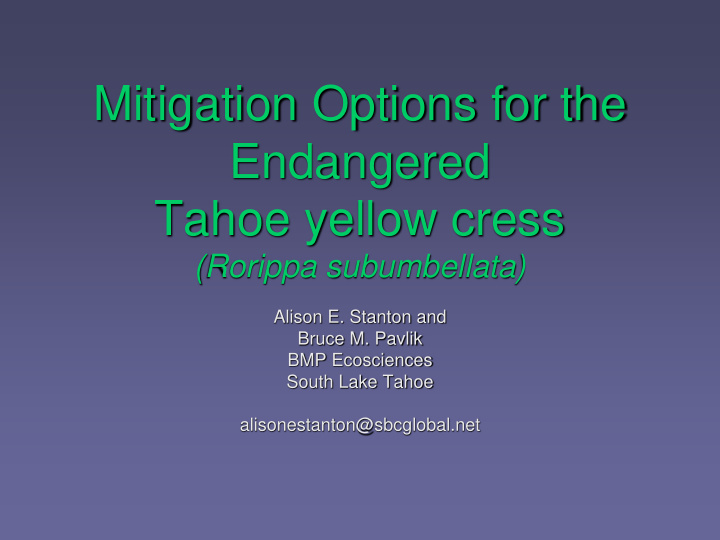



Mitigation Options for the Endangered Tahoe yellow cress (Rorippa subumbellata) Alison E. Stanton and Bruce M. Pavlik BMP Ecosciences South Lake Tahoe alisonestanton@sbcglobal.net
Tahoe yellow cress (TYC) Endangered in CA Critically Endangered in NV TRPA threshold species Candidate for federal protection under ESA
Habitat and Threats Restricted to sandy beach below high water line Beach use and trampling Water management: Reservoir management : sustained high lake 6,222 – 6,229.1 ft LTD levels
9 sites in 1999
Conservation Strategy Adopted in 2002 Adaptive Management Working Group (AMWG) meets quarterly 6 Goals and associated Objectives for recovery Collaborative research program started in 2003
Post CS 46 sites in 2009 6,223 ft 24 sites in 2006 6,228 ft
Project-related impacts to TYC All regulations TRPA SHOREZONE CODE 75.2.A Sensitive Plants: Projects require full and activities in the vicinity of mitigation of actual sensitive plants or their associated habitat, shall be or potential regulated to preserve sensitive significant impacts. plants and their habitat. All projects or activities that are likely to harm, destroy, or otherwise jeopardize sensitive plants or their habitat, shall fully mitigate their significant adverse effects.
No projects have required any mitigation other than avoidance Mitigation Tool box Project re-design Plant flagging Fencing Construction personnel education
AMWG: Experimental plantings from 2003-09 10,000 container-grown plants at 14 sites outplanting translocation
What we know about outplanting with container-grown TYC What types of container-grown plants to use (good roots, mixed seed sources) How to propagate quality container-grown plants When to plant (optimal lake elevation and seasonality factors) The Where is more problematic
Where (within a site): plant performance improves with decreasing depth to the water table 100 90 80 70 Mean Reproduction (% of survivors) 60 Moist shoreline 50 Low Beach High Beach 40 30 20 10 0 6/9/2004 6/23/2004 7/19/2004 8/17/2004 9/14/2004 10/14/2004
Where (among sites) : Survivorship and reproduction highly variable among sites
When: early planting in June is better than later planting in August or Sept
How does translocation compare with outplanting? Paired design: 50 container-grown 50 translocants
Pattern of differential survivorship among sites is inconclusive 2009 cohort year 2 survivorship (% of cohort 100 90 80 70 60 50 40 30 20 10 0 Ebright NV Pope UTE Translocant Container
Container-grown plants perform greater than translocated plants
Container-grown Translocation
Mitigation Toolbox NOW Avoidance Population enhancement or creation Outplanting of container-grown plants Translocation
Current and future projects will require mitigation Storm water quality improvements Erosion control River and stream restoration Lake shore development Pier and boating facilities
Mitigation: what are the options? On-site plantings: if habitat is available Off-site plantings: if no suitable habitat Need for a reference site to assess planting success Attempt translocation or use container- stock?
Choosing a planting site TYC performance is highly microsite- specific: absence of TYC may equal unsuitable habitat
Moving plants to a public enclosure Transfers responsibility and sets an undesirable precedent Lacks conservation value because those sites are already “saturated” with TYC
TYC is not like typical rare plants Little genetic variation or evidence of population architecture Vigorous clonal growth and prolific seed production Metapopulation dynamic: presence and absence linked to lake levels
Standard regulations are difficult to apply Assessing impact may be difficult “perpetuity” requirements for protection of plants or habitat are not biologically feasible
So what do we do? Utilize an Adaptive Management approach and the knowledge of the AMWG to assess project impacts and specify mitigation Update Conservation Strategy with research results Re-new the MOU to implement the CS
Acknowledgements AMWG members Funding CA Dept of Fish and Game Section 6 SNPLMA – contract administration through the USFS LTBMU
Recommend
More recommend